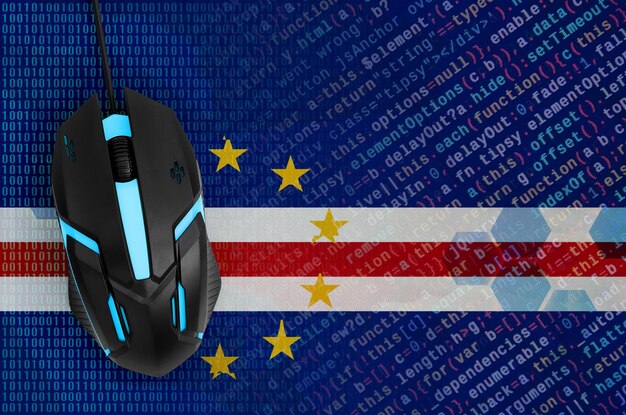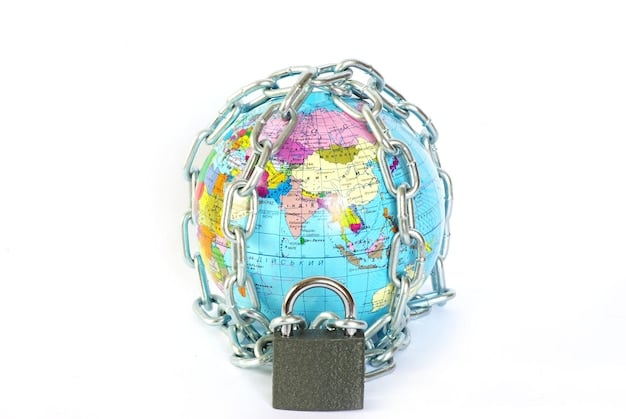US-EU Data Privacy Agreement: Implications for American Citizens

The new US-EU Data Privacy Agreement aims to restore trust in transatlantic data flows, offering American citizens enhanced rights and protections regarding their personal data, but challenges remain in ensuring effective enforcement and addressing potential government access.
The **implications of the new US-EU Data Privacy Agreement for American citizens** are significant, potentially reshaping how personal data is handled across the Atlantic. This agreement seeks to bridge the gap left by previous failed attempts, like Safe Harbor and the Privacy Shield, aiming to ensure that data transfers between the US and the EU are conducted securely and with respect for individual rights.
Understanding the New US-EU Data Privacy Framework
The new US-EU Data Privacy Framework represents a renewed effort to facilitate transatlantic data flows while protecting the privacy rights of individuals. It comes after years of legal challenges to previous agreements and aims to provide a more stable and reliable framework for data transfers.
Background of the Agreement
The agreement stems from concerns raised by the Court of Justice of the European Union (CJEU) regarding the adequacy of US data protection laws. The CJEU invalidated the previous Safe Harbor and Privacy Shield agreements due to concerns about US government surveillance and the lack of effective remedies for EU citizens.
Key Components of the Framework
The new framework includes commitments from the US government to strengthen privacy protections and enhance oversight mechanisms. It also provides EU citizens with new avenues to seek redress if they believe their data has been mishandled.
- Commitments from the US to limit access to data by US intelligence agencies.
- Establishment of a Data Protection Review Court to independently investigate complaints.
- Increased obligations for US companies to protect personal data transferred from the EU.

In conclusion, the new US-EU Data Privacy Framework is designed to address the shortcomings of its predecessors by enhancing privacy protections and providing stronger enforcement mechanisms. This framework aims to restore confidence in transatlantic data flows and safeguard the rights of individuals.
Rights and Protections for American Citizens
While the agreement primarily focuses on protecting the data of EU citizens, it also carries implications for American citizens, particularly concerning the standards and practices that US companies must adopt when handling data.
Data Security Standards
With the new framework, US companies have to adhere to a higher standard of data security, regardless of whether the data originates from the EU or the US. This means that American citizens may indirectly benefit from enhanced data protection practices.
Transparency and Control
American citizens may see an increase in transparency regarding how their data is collected, used, and shared. The agreement may encourage companies to provide individuals with more control over their personal information, such as the ability to access, correct, or delete their data.
The US-EU Data Privacy Agreement doesn’t directly grant new rights to American citizens but it increases awareness and expectations for data privacy. As companies work to comply with the agreement for EU data, American citizens may also see improvements in how their data is handled.
How the Agreement Impacts Data Transfers
The primary purpose of the agreement is to facilitate the smooth transfer of data between the US and the EU. This data is essential for various business operations, including marketing, customer service, and research and development.
Simplified Data Transfer Processes
The new framework simplifies the process for US companies to receive personal data from the EU. Previously, companies had to rely on Standard Contractual Clauses (SCCs) or Binding Corporate Rules (BCRs), which could be complex and time-consuming to implement.
Economic Benefits
By providing a more stable and predictable legal framework, the agreement can help boost transatlantic trade and investment. Companies can transfer data with greater certainty, allowing them to innovate and expand their operations.
- Reduced compliance costs for US companies.
- Increased opportunities for EU businesses to access the US market.
- Enhanced collaboration between US and EU researchers and innovators.
Overall, the new agreement aims to create a more seamless and efficient system for data transfers between the US and the EU. This enhances economic opportunities and improves the overall business environment on both sides of the Atlantic.
Potential Challenges and Criticisms
Despite its potential benefits, the new agreement is not without its challenges and criticisms. Some privacy advocates and legal experts have raised concerns about the effectiveness of the proposed safeguards and the potential for government overreach.
Concerns about Government Surveillance
One of the main criticisms of previous agreements was the potential for US government surveillance of EU citizens’ data. While the new framework includes commitments to limit access to data, some critics remain skeptical that these commitments will be fully enforced.
Enforcement Issues
Another challenge is ensuring that US companies comply with their obligations under the agreement. The framework relies on self-certification by companies, with enforcement primarily handled by the US Federal Trade Commission (FTC). Some critics worry that the FTC may lack the resources and expertise to effectively monitor compliance.

Addressing these challenges and criticisms will be crucial to ensuring that the new agreement is a success. Strengthening oversight mechanisms, increasing transparency, and providing effective remedies for individuals will be essential to building trust in the framework.
The Role of the Data Protection Review Court
A key component of the new framework is the establishment of a Data Protection Review Court (DPRC). This independent body is designed to investigate complaints from EU citizens who believe their data has been mishandled by US companies or accessed unlawfully by US intelligence agencies.
Functionality of the DPRC
The DPRC will have the power to review decisions made by US intelligence agencies and order remedies if it finds that the law has been violated. This includes the ability to order the deletion or correction of data.
Independence and Impartiality
To ensure its independence and impartiality, the DPRC will be composed of judges with expertise in data protection law. These judges will be selected from outside the US government, providing an additional layer of oversight.
The creation of the DPRC represents a significant step forward in providing EU citizens with effective remedies for data privacy violations. By offering an independent forum for resolving disputes, the DPRC seeks to enhance trust in transatlantic data flows and strengthen the overall framework.
Implications for American Businesses
The US-EU Data Privacy Agreement also has several implications for American businesses that operate in the EU or transfer data from the EU to the US. Compliance with the framework is essential for maintaining access to the EU market and avoiding legal challenges.
Compliance Requirements
US companies that wish to participate in the framework must self-certify their compliance with the principles outlined in the agreement. This involves updating their privacy policies, implementing appropriate data security measures, and providing individuals with rights to access, correct, and delete their data.
Potential Liabilities
Companies that fail to comply with the framework may face enforcement actions from the FTC, as well as potential lawsuits from individuals whose data has been mishandled. It is crucial for businesses to take their compliance obligations seriously and invest in appropriate data protection measures.
- Conduct regular privacy assessments.
- Train employees on data protection practices.
- Establish clear procedures for responding to data breaches.
In conclusion, the new agreement creates both opportunities and challenges for American businesses. By embracing strong data protection practices and complying with the framework, companies can build trust with their customers, enhance their reputation, and maintain access to the lucrative EU market.
Future Outlook and Developments
The US-EU Data Privacy Agreement is a dynamic framework that will likely evolve over time as new technologies emerge and data protection laws continue to develop. It is essential for businesses and individuals to stay informed about the latest developments and adapt their practices accordingly.
Anticipated Changes
In the future, we may see further refinements to the agreement to address emerging challenges, such as the increasing use of artificial intelligence and the growing volume of data being transferred across borders. Policymakers may also consider additional measures to enhance enforcement and oversight.
Continued Dialogue
Ongoing dialogue between the US and the EU will be crucial to ensuring that the framework remains effective and relevant. This includes regular consultations with stakeholders, such as privacy advocates, industry representatives, and government officials.
💡 Key Benefits: Clearer data transfer rules, enhanced data protection for citizens, and streamlined compliance for businesses.
🛡️ Data Protection Review Court: Offers independent resolution for EU citizens’ data complaints against US entities.
🌐 Global Impact: Sets a precedent for international data agreements amid rising data protection concerns.
⚖️ Compliance: US companies must self-certify and adhere to strict privacy standards for data handling.
| Key Point | Brief Description |
|---|---|
| 💡 Benefits | Simplifies data transfers and strengthens data protection. |
| 🛡 Protection Court | Offers a recourse for EU citizens regarding US data practices. |
| 🌐 Global Impact | Sets standards for international data agreements worldwide. |
| ⚖ Compliance | Companies must certify and follow privacy rules strictly. |
Frequently Asked Questions
▼
The primary goal is to establish a reliable framework for transatlantic data transfers while ensuring the privacy and protection of personal data, particularly for EU citizens.
▼
It introduces stronger commitments from the US government to limit data access and creates a Data Protection Review Court for independent investigation of complaints.
▼
EU citizens have the right to access, correct, and delete their data held by US companies, and can seek remedies through the Data Protection Review Court if their data is mishandled.
▼
American companies must self-certify their compliance, adhere to stricter data protection standards, and face potential enforcement actions for non-compliance.
▼
Challenges include concerns about US government surveillance, ensuring effective enforcement by the FTC, and addressing potential legal challenges from privacy advocates.
Conclusion
The new US-EU Data Privacy Agreement is a significant step toward restoring trust in transatlantic data flows and protecting the privacy rights of individuals. While challenges remain, the agreement provides a more stable and reliable framework for data transfers, offering enhanced rights and protections for both EU and American citizens.





